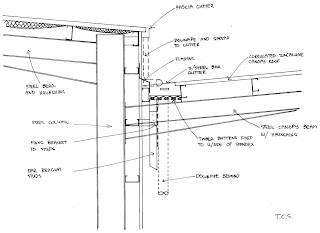Sunday, April 29, 2007
Site Visit #2
This is a two storey residential apartment block, comprising of 20 units from memory, that I visited in Hampton. Whilst I was taking photographs of the building from outside the security fence, I was fortunate enough to be spotted by the construction manager, who got out of his car and happily showed me through the building.
 Drainage pipes and tanking to sub-basement structure.
Drainage pipes and tanking to sub-basement structure.
 Workmen's scaffolding platforms.
Workmen's scaffolding platforms.
 Heavy precast panels that frame the main entrance to the building. Adjacent walls showing rebated lines on precast panels for ornamentation.
Heavy precast panels that frame the main entrance to the building. Adjacent walls showing rebated lines on precast panels for ornamentation.
 Acro props working to temporariliy support the curing slab above.
Acro props working to temporariliy support the curing slab above.
 High density/strength reinforced precast concrete beams holding the weight of the above bondeck and slab. Reduces the required space for the floor/ceiling cavity.
High density/strength reinforced precast concrete beams holding the weight of the above bondeck and slab. Reduces the required space for the floor/ceiling cavity.
 Services penetration through bondeck slab. Most likely for smoke detectors.
Services penetration through bondeck slab. Most likely for smoke detectors.
 Steel connection plates welded to adjoining concrete precast panels. Combined with the insitu floor slab this creates ample rigidity between the wall panels. Also, caulking between panels is evident, working as a membrane against moisture penetration.
Steel connection plates welded to adjoining concrete precast panels. Combined with the insitu floor slab this creates ample rigidity between the wall panels. Also, caulking between panels is evident, working as a membrane against moisture penetration.
Wednesday, April 25, 2007
Major Project
As an architecture student, the project brief outlined that I must choose an eminent architect and an associated material that the architect was known to have used extensively in their oeuvre.
After initially deciding to select the famed Australian architect Harry Seidler (and his associated love for reinforced concrete), I decided to expand my horizons by choosing an equally fascinating architect, but one with which I was not as familiar with.
After initially deciding to select the famed Australian architect Harry Seidler (and his associated love for reinforced concrete), I decided to expand my horizons by choosing an equally fascinating architect, but one with which I was not as familiar with.

Ultimately, I decided to choose the Finnish modernist, Alvar Aalto. To me, his stunning austerity and harmonious compositions remain utterly seductive. A distinct set of personal design principles allowed Aalto to generate a style devoid of romantic excess, creating functional yet non-reductionist buildings.
Whilst Aalto explored a number of diverse materials, a favourite of his was the masonry; in particular, the plain but honest brick. Consequently, I have selected the brick as the main material element in my investigation.
Additionally, I will perhaps explore the nailed timber trusses that Aalto had been known to use in some of his longer spanning buildings such as the Sports Hall in Otaniemi (1952).
Thursday, April 19, 2007
Site Visit #1
This construction site is located on the corner of Bay St. and Cochrane St. in Brighton (South-east Melbourne). It is a small/medium sized commercial buildilng, with both office and retail spaces spread over three levels, in addition to a two level basement. A number of precast concrete panels have been elevated in the last few days, and the overall form of the building is starting to take shape.

This is a graphic interpretation of the proposed building.

Here we can view some external precast concrete tilt-up panels with temporary props. The photo also shows some shade cloth which helps reduce the flow of dust and debris off site. Safety railing is also present.

Scaffold props and temporary support beams are ready for the bondeck formwork to be placed upon.

This photographs shows a steel reinforcing cage for a concrete column. It is awaiting the application of some formwork to shape the concrete pour about the rio. Note that starter rods from the previous pour are connected to the new cage to help produce a level of structural homogeneity.

Here we can see the proposed lift shaft made from prefabricated concrete panels, with its temporary props.
This is a graphic interpretation of the proposed building.
Here we can view some external precast concrete tilt-up panels with temporary props. The photo also shows some shade cloth which helps reduce the flow of dust and debris off site. Safety railing is also present.
Scaffold props and temporary support beams are ready for the bondeck formwork to be placed upon.
This photographs shows a steel reinforcing cage for a concrete column. It is awaiting the application of some formwork to shape the concrete pour about the rio. Note that starter rods from the previous pour are connected to the new cage to help produce a level of structural homogeneity.
Here we can see the proposed lift shaft made from prefabricated concrete panels, with its temporary props.
Tuesday, April 17, 2007
Monday, April 16, 2007
Subscribe to:
Posts (Atom)





